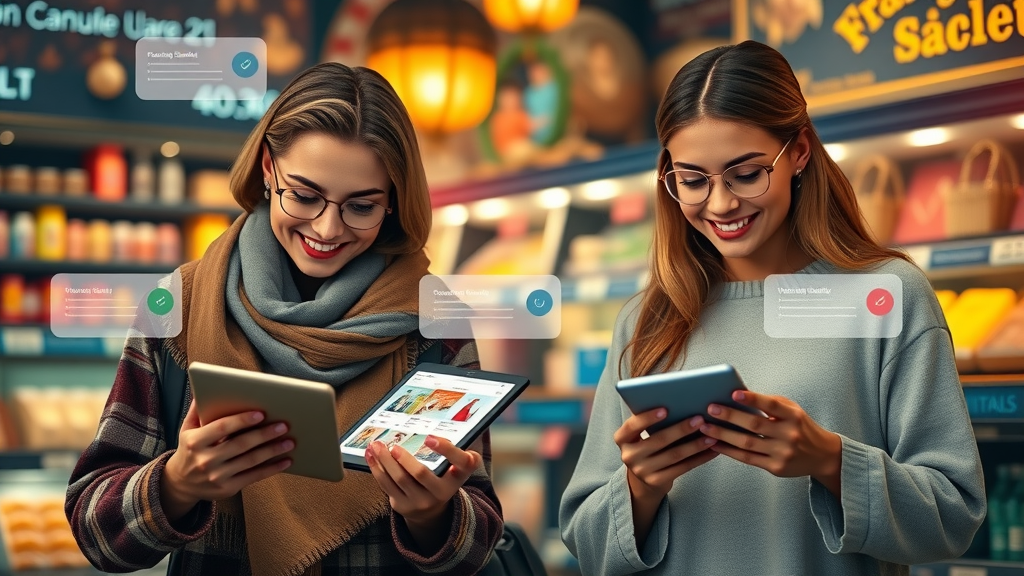Did you know that 80% of consumers are more likely to make a purchase from a brand that offers personalized experiences? With today's crowded digital marketplace, generic marketing campaigns just can’t compete with strategies tailored directly to individual interests and preferences. If your goal is to fuel business growth and increase engagement quickly, personalized marketing techniques are your pathway to instant results. This guide will show you how leading brands craft winning campaigns that multiply conversion rates, ramp up customer retention, and deliver exceptional experiences—starting today!

Revealing the Power of Personalized Marketing Techniques: Surpassing Generic Campaigns
- Discover how 80% of consumers are more likely to buy from brands offering personalized experiences, and why tailored marketing campaigns can triple your conversion rate.
The shift towards personalized marketing techniques is not just industry hype—it's a response to data-driven realities. Brands investing in personalized campaigns see as much as three times higher conversion rates than those sticking to bland, generic communication. Essentially, when you deliver content and offers tailored to individual needs and behaviors, customers feel understood and valued, making them more inclined to act.
Relying on marketing personalization enables you to break through advertising noise. While many companies still run mass email campaigns or untargeted ads, the most successful brands leverage customer data to design touchpoints that feel relevant and timely. Think Netflix suggesting your next favorite show or Spotify curating playlists just for you—those aren’t happy accidents, but the result of sophisticated personalized marketing campaigns that directly address consumer preferences.
If you’re still on the fence about pivots to personalization, here’s the bottom line: With the right marketing strategy , personalized outreach not only increases immediate conversion rates but also boosts lifetime value by cultivating loyalty and trust. Let’s explore why this approach is now essential for anyone serious about instant growth.
Achieving Rapid Results: Why Personalized Marketing Techniques Are Essential for Growth
Every marketing team wants results, and fast! Traditional one-size-fits-all marketing campaigns simply can’t compete with the nimbleness and direct appeal of personalized marketing techniques . By leveraging available customer data , you can deeply understand what your potential customers genuinely want, allowing you to address their needs at the right moment and on the right channel.
The main keyword advantage isn’t only in efficiency but also in tangible returns. A personalized marketing strategy allows for highly targeted offers, relevant content, and dynamic messaging. This translates into higher open rates for emails, more engaged website visitors, and a greater share of loyal repeat buyers. Campaigns move from "spray and pray" to data-powered precision, amplifying every marketing dollar you spend.
Practical examples abound: Think about dynamic coupons sent post-purchase, AI-powered product recommendations on e-commerce websites, or even just emails with a personalized subject line and offer. When executed right, these techniques not only maximize conversion rate but dramatically improve customer retention —creating instant growth now and stronger relationships for the future.
Personalized Marketing Versus Traditional Marketing Campaigns: Impact and ROI

Let’s compare the impact of traditional versus personalized approaches. Traditional campaigns cast a wide net, often resulting in wasted resources and low engagement. Personalized campaigns, however, zero in on segments or individuals with content, offers, and messaging that feel uniquely crafted. This shift leads directly to a spike in open rate , conversion rate , and—perhaps most importantly— customer retention . In fact, leading brands report as much as a 20% increase in revenue simply by personalizing key marketing touchpoints.
Not only do personalized marketing strategies boost performance, but they also encourage brand loyalty by fostering a personal connection between your business and its audience. Customers who feel recognized and valued are more likely to become repeat buyers, refer friends, and advocate for your brand on social media . Ultimately, the measurable ROI of personalization makes it a foundational element of any high-performing marketing campaign .
To put this into context, review the comparison below:
| Metric | Personalized Campaigns | Generic Campaigns |
|---|---|---|
| Open Rate | 29-35% | 15-18% |
| Conversion Rate | 5-10% | 1-3% |
| Customer Retention | 40-50% | 20-25% |
Personalized Marketing Techniques in Practice: Complete Guide for Effective Marketing Personalization
Implementing successful personalized marketing techniques means more than just adding names to emails. It requires an integrated approach that harnesses both technology and strategy. The most widespread techniques go far beyond mere customization—they actively adapt campaigns in real-time to changing cues from customer data , purchase history, and engagement metrics. Let’s break down the most proven strategies your marketing team can leverage today.
From leveraging AI-powered engines that serve up tailored product recommendations to launching dynamic personalized email campaigns, modern marketers have an arsenal of tools at their disposal. Audience segmentation ensures you deliver relevant content to each subset of your target audience, while marketing automation allows for real-time personalization at scale. Personalized content —whether an email, product suggestion, or landing page—makes every touchpoint feel designed just for the recipient.
Here are the most impactful personalized marketing techniques to consider for your next marketing campaign :
- Product Recommendation
- Personalized Email Campaigns
- Dynamic Personalized Content
- Audience Segmentation
- AI-Driven Marketing Automation
Integrating Personalized Experience Across All Marketing Campaigns

Delivering a seamless personalized experience isn't just about piecing together isolated personalized ads or emails. Consumers now expect a consistent journey across web, email, mobile, and even offline channels. That means data and personalization strategies must work together—pulling insights from every touchpoint to adapt messaging in real time.
Today’s best marketing campaigns use technology to sync personalization efforts, ensuring a customer who browses online receives a tailored follow-up email and encounters relevant content on social media or mobile apps. This holistic approach not only increases engagement but makes every interaction with your brand more meaningful.
By breaking down silos between marketing platforms—using marketing automation and AI—the customer’s story is remembered and responded to at every step. The result? Greater brand loyalty , higher lifetime value, and a brand reputation for truly listening to its customers.
Strategic Use of Customer Data for Personalized Marketing Techniques
Personalized marketing relies on data as its backbone. Without a steady flow of customer data , it’s impossible to deliver relevant, targeted, and timely offers or messages. Data is not just about demographics—advanced personalization combines transactional, behavioral, and engagement data to create a holistic profile of each potential customer.
Understanding the types of data available, and how to ethically and effectively collect and use it, is the first step toward building a resonant personalized marketing strategy . When paired with analytics and AI, this data becomes the source of actionable insights, allowing you to pivot quickly and keep pace with changing customer behaviors.
Below are the primary types of data your marketing team should capture to power successful personalization efforts:
Data Collection Methods Fueling Marketing Personalization
- Demographics: Age, location, gender, income, and more.
- Behavioral Data: Website clicks, browsing history, search queries.
- Transactional Data: Purchase history, cart activity, order value.
- Psychographics: Interests, values, lifestyles.
- Engagement Metrics: Email opens, social media shares, time on site.
Transforming Customer Data into Actionable Insights for Personalized Marketing

Raw data by itself won’t move the needle—it's what you do with it that counts. Turning customer data into actionable insights means identifying patterns that signal buying intent or churn risk, forecasting product preferences, and unlocking new personalized content opportunities. Tools powered by machine learning and AI can help marketing teams automate this analysis at scale, serving up audience segments ripe for customized messaging.
For instance, your analysis might reveal that customers who repeatedly browse a specific product category but haven’t purchased respond well to targeted discount incentives via personalized email . Or you may find that engagement spikes when website content dynamically shifts to match past behavior. These actionable insights inform your next steps and keep your personalization efforts continually optimized for higher conversion rates and retention.
The ultimate goal: Use every bit of customer data at your disposal to proactively address needs, answer questions, and deliver value before the competition does.
Email Marketing Revolution: Personalized Emails as Cornerstone of Personalized Marketing Techniques
Few tactics drive instant engagement and growth quite like personalized emails . As inboxes overflow, generic blasts get ignored. But highly tailored personalized marketing emails—crafted to speak directly to individual preferences, purchase history, and behaviors—regularly outperform every other digital channel. In fact, “ Personalized email campaigns can drive six times higher transaction rates than generic emails. ”
The secret? From the subject line to AI-driven product recommendations , each component is optimized to connect with recipients emotionally and contextually, maximizing open rate and conversions.
Maximizing Open Rate and Conversion Rate with Tailored Subject Lines
"Personalized email campaigns can drive six times higher transaction rates than generic emails." – Industry Research
It all starts with the subject line , the make-or-break first impression of your email campaign . Data shows that personalizing this single element—by adding a name, referencing a recent purchase or browsing event—can increase open rates by up to 50%. Further, emails that follow up this initial promise with highly relevant copy and offers see an even bigger lift in conversion rates .
For optimum results, segment your audience based on customer data and create multiple versions of your personalized content . Each email should feel as if it was written specifically for the reader—speaking to their current interests, location, or lifecycle stage. This strategy not only maximizes ROI for each marketing campaign but also strengthens the overall customer experience .
Automating Personalized Email Marketing Campaigns for Consistent Results
Personalized email marketing doesn’t have to be a manual, time-consuming effort. With marketing automation and advanced email platforms, you can schedule, segment, and personalize campaigns at scale. For example, welcome series, abandoned cart reminders, and re-engagement campaigns can all use customer data to serve precisely timed, individually crafted messages that drive action.
Automation ensures no opportunity is missed, and every milestone in the customer journey is met with relevant, timely engagement. Marketers can continuously test and optimize for better open rates , click-throughs, and conversion rates , making email a consistent revenue generator for your brand.
By combining automation with strategic use of personalization—triggered by purchase events, browsing history, or seasonal factors—brands can repeatably deliver experiences that delight, driving up customer retention and lifetime value.
Hyper-Personalized Email Content and Product Recommendations
The future of email marketing is hyper-personalization, powered by data and AI. Go beyond first names and surface products, content, and offers picked just for a given user, based on their real-time behavior and preferences. Sophisticated product recommendation engines now allow for “one-to-one” marketing at incredible scale—suggesting accessories, content, or updates at just the right moment.
As customers see their tastes and interests reflected in every message, the results are clear: Higher open and conversion rates , stronger satisfaction, and an enduring relationship built on value—not spam. To sum up: Personalized emails aren’t just a tactic—they’re now a must-have foundation for any modern brand’s marketing personalization strategy.
Personalized Content Strategies: Engaging Audiences with Tailored Experiences
Delivering personalized content—across web, email, and more—keeps audiences engaged and improves your chances of both conversion rate and customer retention . Today, static websites or standard blog posts rarely suffice. Instead, brands are evolving toward real-time content adaptation based on user behavior, preferences, and customer data .
Dynamic content enables a more immersive and relevant user journey. From homepage banners to custom product recommendations, real-time personalization creates unique experiences for every visitor, ensuring your site feels alive and uniquely theirs each time they return.
Meanwhile, interactive and multimedia elements—think videos, quizzes, or calculators—bring another layer of individuality to marketing personalization , deepening engagement and accelerating the path from interest to action.
Dynamic Website Content and Product Recommendations

Personalized website experiences are the new standard. By tapping into browsing history, geolocation, or purchase history , smart platforms can automatically display products, content, or offers most likely to align with each visitor’s desires—no extra work from your team needed. This capability can double or triple conversion rates compared to static, “one-size-fits-all” web pages.
For example, when a user puts a new pair of shoes in their shopping cart, your site can suggest matching accessories or offer a discount on a complementary item. Similarly, content portals can recommend videos or articles based on prior interactions, further encouraging return visits and increased customer retention .
Product recommendations and dynamic content not only help guide users toward purchase but also make every interaction more meaningful—fostering strong brand loyalty and a reputation for meaningful, user-centric experiences.
Role of Personalized Video and Interactive Content in Marketing Personalization
Video is the future of content, but not all videos are created equal. Personalized video marketing lets brands use data points (name, recent purchase, location) to create unique experiences at scale. Sending a post-purchase thank-you video that directly addresses the shopper by name, for example, increases the odds of repeat business and social shares.
Interactive content—like personalized quizzes, calculators, or chatbots—engages users far more deeply than static content. These tools gather additional customer data while offering real value. Each interaction makes your brand more memorable and your marketing campaigns more persuasive, adding to increased conversion rates and overall satisfaction.
Ultimately, using personalized video and interactive experiences transforms passive visitors into active participants, driving greater retention and a more profitable long-term relationship.
Elevating Social Media Engagement Through Personalized Marketing Techniques
Social media is where real-time conversation, influencer power, and rapid shifts in audience interests happen. To keep pace, brands are leveraging personalized marketing techniques fueled by rich customer data —from what users like and share to how they interact with content. The result? Social feeds that feel local, timely, and personally relevant.
Personalizing interactions on social media not only increases audience engagement but also improves ROI, as messages are fine-tuned per user or segment. Blending geo-targeting, custom audiences, and AI-powered post suggestions, high-performing brands spark genuine conversations and loyalty.
This approach makes social platforms a crucial line of defense and growth for customer retention and personalized brand loyalty .
Utilizing Customer Data to Deliver Personalized Social Media Campaigns

The magic of marketing personalization on social media comes from intelligent use of customer data . From post timing to content format, each element can be adjusted based on known behaviors and preferences. Brands can utilize AI to analyze when users are most active, what topics they care about, and which products are trending in a follower's circle.
For instance, a popular strategy is to run geo-targeted ads or organic posts based on a user’s city or neighborhood—making the approach feel much more immediately relevant. Custom audience lists built from website and email engagement signal where prospects are in their journey, allowing for coordinated, personalized offers across platforms.
Here are practical best practices for personalized social campaigns:
- Geo-targeted ads
- Custom audience lists
- AI-powered content suggestions
Personalized Marketing Automation: The Backbone of Scalable Campaigns
The biggest limitation for many marketing teams is the ability to scale personalized touchpoints without ballooning workload. That’s where marketing automation comes in. By automating repetitive tasks, segmenting audiences in real time, and deploying dynamic content automatically, brands can reach millions with customized experiences—without human bottlenecks.
Modern marketing automation tools do more than send emails—they help dictate ad flows, trigger personalized onsite experiences, and run complex, multichannel marketing campaigns that are always “on.” As a result, every customer interaction—no matter the channel—can be optimized for relevance, speed, and effectiveness.
Ultimately, marketing automation allows brands to achieve instant growth by deploying hyper-targeted outreach at scale—a game-changer in a world where relevance drives results.
Leveraging Marketing Automation Platforms for Real-Time Personalization

With advanced automation tools, you no longer have to choose between scale and personalization. Platforms can monitor customer behaviors across channels, trigger personalized messages or ad content in seconds, and adapt strategies as audience segments evolve. This means no more missed opportunities, regardless of the size or diversity of your audience.
Brands that excel here are those tapping into real-time analytics—for example, instantly displaying a special offer to a user who’s spent time viewing a specific product or retargeting users on social media with the exact item they browsed earlier. The result is a seamless, ongoing dialogue that maximizes conversion rates at every stage of the buyer journey.
Investing in marketing automation platforms is essential for any brand looking to achieve consistent, scalable, and data-driven personalized marketing success. Find technology that easily syncs with your data sources, website, email, and ad channels for best results.
AI and Machine Learning: Enhancing the Depth of Personalized Marketing
"Marketing automation delivers relevant experiences without manual effort, increasing both efficiency and loyalty." – Martech Thought Leader
The rise of AI and machine learning has supercharged marketing automation. These technologies learn from every interaction, enabling brands to predict which products to promote, when to communicate, and how to present offers for maximum impact. As a result, personalized marketing techniques become more effective over time as your AI system learns and auto-optimizes.
For example, AI can spot subtle changes in customer behavior (like shifting from a desktop to a mobile device) and adapt the marketing touchpoint accordingly. It can even curate personalized product recommendations or suggest personalized content formats for higher engagement. The blend of AI insight with automation’s scalability makes real-time personalization a reality, delivering exceptional value and brand loyalty .
To master marketing personalization , invest in solutions that couple automation with AI, so you can move from “set and forget” to “learn and evolve” marketing strategies.
Designing a High-Performing Personalized Marketing Strategy
Creating a high-converting personalized marketing strategy means being intentional at every stage—starting with planning and ending with optimization. Knowing how to segment audiences, pick the right channels, and leverage customer data for tailored messaging is essential for scalable success.
A smart marketing strategy begins by clearly defining your objectives, mapping out data collection processes, and segmenting users based on meaningful criteria. Only then should you deploy personalized content —never before! The most successful brands then monitor every campaign, adapting in real time to maximize open rate , conversion rate , and brand loyalty .
Your playbook for building personalization should look like this:
- Define Objectives
- Gather & Analyze Customer Data
- Segment Customers
- Deploy Personalized Content
- Monitor Performance
Segmentation and Targeting: Mapping the Path to Personalized Experience
Segmentation is the engine of an effective personalized marketing campaign . Instead of treating your audience as a monolith, group them by shared traits—demographics, behavioral signals, shopping patterns, and more. Smart targeting increases conversion rates and minimizes spend on uninterested users.
Whether you segment by lifecycle stage, previous purchase, or content preferences, your marketing team can create laser-focused messaging for each group. This unlocks individualized customer experiences and primes your brand for long-term retention and loyalty that mass campaigns can’t replicate.
The secret to winner campaigns: Rely on granular segmentation coupled with real-time triggers—ensuring every user receives the right message, on the right channel, at the right moment.
Optimizing the Customer Journey: From Attraction to Retention
Personalization isn’t just for acquisition. It’s a full-funnel effort that starts with first contact and extends throughout the relationship—attracting potential customers, nurturing interest, delighting at purchase, and inspiring ongoing engagement. Key personalization triggers at each stage boost both satisfaction and measurable business results.
Tracking behavioral clues, repeat purchases, and engagement signals allows your team to serve personalized product recommendations , exclusive loyalty rewards, or individualized re-engagement offers. The top brands constantly optimize the journey for every user with data-driven decision-making.
Here’s a table illustrating the key stages and triggers for effective marketing personalization:
| Stage | Key Personalization Triggers |
|---|---|
| Attraction | Website visit, content click, ad engagement |
| Consideration | Product page view, download, add to cart |
| Conversion | Purchase, sign-up, new account creation |
| Retention | Repeat purchase, loyalty program participation, NPS feedback |
| Advocacy | Social media sharing, referrals, product reviews |
Enhancing Brand Loyalty and Customer Retention with Personal Touches
Brand loyalty and customer retention are direct results of a smart, data-powered personalization effort. By making every customer feel recognized—through birthday emails, purchase anniversaries, exclusive offers, or personalized recommendations—you deepen trust and attachment, reducing churn risk.
Simple gestures build emotional connections. Loyalty programs that adapt rewards based on user preferences, thank-you notes after major milestones, and regular personalized content based on evolving behavior help cement your brand as irreplaceable in your customers’ lives.
Focus on small, scalable “wow” moments, and watch your advocates become both your best customers and fiercest promoters on social media and beyond.
Ethics and Privacy: Ensuring Responsible Use of Customer Data in Personalized Marketing

As you gather more customer data to fuel personalization, ethical responsibility becomes paramount. Transparency about what information is collected and why, securing explicit consent, and offering clear opt-out options are no longer optional—they’re a brand imperative.
Building trust means prioritizing privacy alongside personalization. Failing to do so can result in reputational damage and lost business. The best marketing teams now use data responsibly, limit collection to what’s necessary, and are clear with customers on how data powers a better, more relevant experience.
Remember: Trust is built every time you transparently communicate data practices, honor privacy choices, and use insights exclusively to improve the customer journey—not just your bottom line.
Transparency, Consent, and Building Customer Trust
"Personalization must walk hand in hand with privacy for enduring brand credibility." – Data Ethics Consultant
Today’s consumers are more informed than ever—and more willing to walk away from brands that misuse their data. Provide robust privacy policies, clear consent options, and always honor user preferences. This transparency not only helps you meet compliance standards but also enhances trust, creating long-term brand advocates.
Empower users with control over their data, from managing preferences to easily opting out of personalized offers or communications. Maintaining this respectful balance between personalized marketing techniques and user autonomy is the key to ethical, effective business growth.
In short: For your personalized marketing strategy to thrive, prioritize both relevance and respect, showing customers you value their privacy as much as their patronage.
Case Studies: Brands Fueling Instant Growth with Personalized Marketing Techniques
To see just how impactful personalized marketing techniques can be, let's examine some real-world examples from e-commerce, retail, and SaaS giants:
E-commerce: Boosting Conversion Rate with Advanced Product Recommendations

Amazon’s personalized product recommendation engine is a gold standard. By analyzing user purchase history and browsing behavior, Amazon effectively suggests products uniquely likely to appeal to every user—leading to soaring conversion rates and impressive growth in average order values. These dynamic, data-driven suggestions create a seamless, satisfying customer experience with every visit.
Similar techniques are now used by brands of all sizes: From suggested add-ons at checkout to tailored “best for you” collections, this strategy turns even casual browsing into actionable sales and repeat purchasing.
The impact? A dramatic increase in order frequency, customer satisfaction, and positive reviews—testaments to the power of marketing personalization at work.
Retail: Driving Customer Retention Through Hyper-Personalized Loyalty Programs
Leading retailers like Sephora and Starbucks use loyalty apps that profile users’ purchase frequency, preferences, and engagement habits—then unlock custom rewards, early access, or perks tailored to the individual. By making every reward feel earned and uniquely suited, these programs massively boost customer retention while driving ongoing, repeat visits.
Hyper-personalized loyalty not only incentivizes more visits, but turns the loyalty program into a dynamic driver of both data collection and customer advocacy—making customers eager to opt-in and engage. These efforts help retailers maintain relevance in highly competitive markets.
Bottom line: The line between “marketing” and “service” blurs when loyalty programs deliver both utility and delight, generating both top-line and bottom-line growth via data-powered personalization.
SaaS: Increasing Open Rate and Brand Loyalty via Targeted Email Marketing
SaaS leaders like HubSpot and Grammarly deploy advanced segmentation and trigger-based personalized email campaigns to onboard new users, re-engage dormant ones, and upsell add-ons. By analyzing actions taken—or not taken—on their platforms, they craft tailored messaging that speaks directly to each subscriber’s journey and needs.
This high-touch approach regularly produces industry-leading open rates and sharp boosts in free-to-paid conversion. By combining in-app data with email engagement histories, these brands foster high trust, ongoing delight, and enduring loyalty, demonstrating the expansive possibilities of personalized marketing techniques in a digital-first economy.
The lesson: Whatever your size or sector, you can adapt similar data-driven personalization to drive instant—and sustainable—growth.
People Also Ask
What are personalized marketing strategies?
Personalized marketing strategies are tailored approaches that use data insights, customer behaviors, and segmentation to deliver uniquely relevant messaging, products, or offers to each customer or segment, with the goal of boosting engagement, conversion rate, and customer retention.
What is an example of personalization marketing?
A leading example is Amazon’s product recommendation engine, which analyzes previous purchases and browsing patterns to suggest products uniquely suited to each user—dramatically increasing both conversion rate and average order value.
What are the four ds of personalization?
The four Ds of personalization are Data Collection (gathering customer data), Decisioning (using AI/analytics to determine action), Design (creating the personalized experience), and Delivery (executing across channels).
What is a custom marketing strategy?
A custom marketing strategy is a marketing plan uniquely crafted to address the specific needs, goals, and market dynamics of a particular business or audience segment, integrating personalized marketing techniques for higher effectiveness.
Commonly Used Personalized Marketing Techniques Checklist
- Personalized emails
- Dynamic content
- Product recommendation engines
- Segmented campaigns
- Real-time offers
- Personalized messaging via chatbots
- Social media retargeting
- Loyalty program personalization
Frequently Asked Questions

How do I start implementing personalized marketing techniques?
Begin by setting clear marketing objectives, then gather and unify customer data from your website, CRM, email, and social channels. Segment your audience and use simple personalization (such as names in emails or location-based offers) to get started. As you scale, integrate automation tools and AI to further refine and expand your efforts.
Which tools are best for marketing personalization?
Look for platforms like HubSpot, Salesforce Marketing Cloud, Mailchimp, and Klaviyo—these systems allow for robust audience segmentation, email personalization, dynamic content, automation, and integration with your existing data stacks. The right tool will depend on your scale, budget, and the channels you want to optimize.
How can I balance personalization with customer privacy?
Clearly inform users about what data is collected and why. Always seek explicit consent, provide easy opt-out methods, and use data responsibly for the customer’s benefit. Adhering to privacy laws (like GDPR or CCPA) and being transparent in your practices is essential to building trust and long-term relationships.
What metrics should I track to measure personalized marketing success?
Focus on open rate and click-through rate for emails, conversion rate for campaigns, engagement metrics on web and social, customer retention rates, and overall ROI. Tracking these over time helps you identify which personalization tactics deliver the most value and where to refine your approach for even stronger results.
Key Insights for Mastering Personalized Marketing Techniques
- Personalization is critical for conversion rate and retention
- Customer data underpins all effective marketing personalization
- Automation enables scalable, real-time personalized experiences
- Ethical data use builds consumer trust and long-term loyalty
Take Action: Transform Your Marketing Results with Personalized Marketing Techniques
Start today: Review your data, segment your audiences, and launch a simple personalized email campaign or dynamic website experience. From there, continuously collect feedback and iterate, leveraging automation and AI for instant growth and sustainable loyalty.
 Add Row
Add Row  Add
Add 





Write A Comment